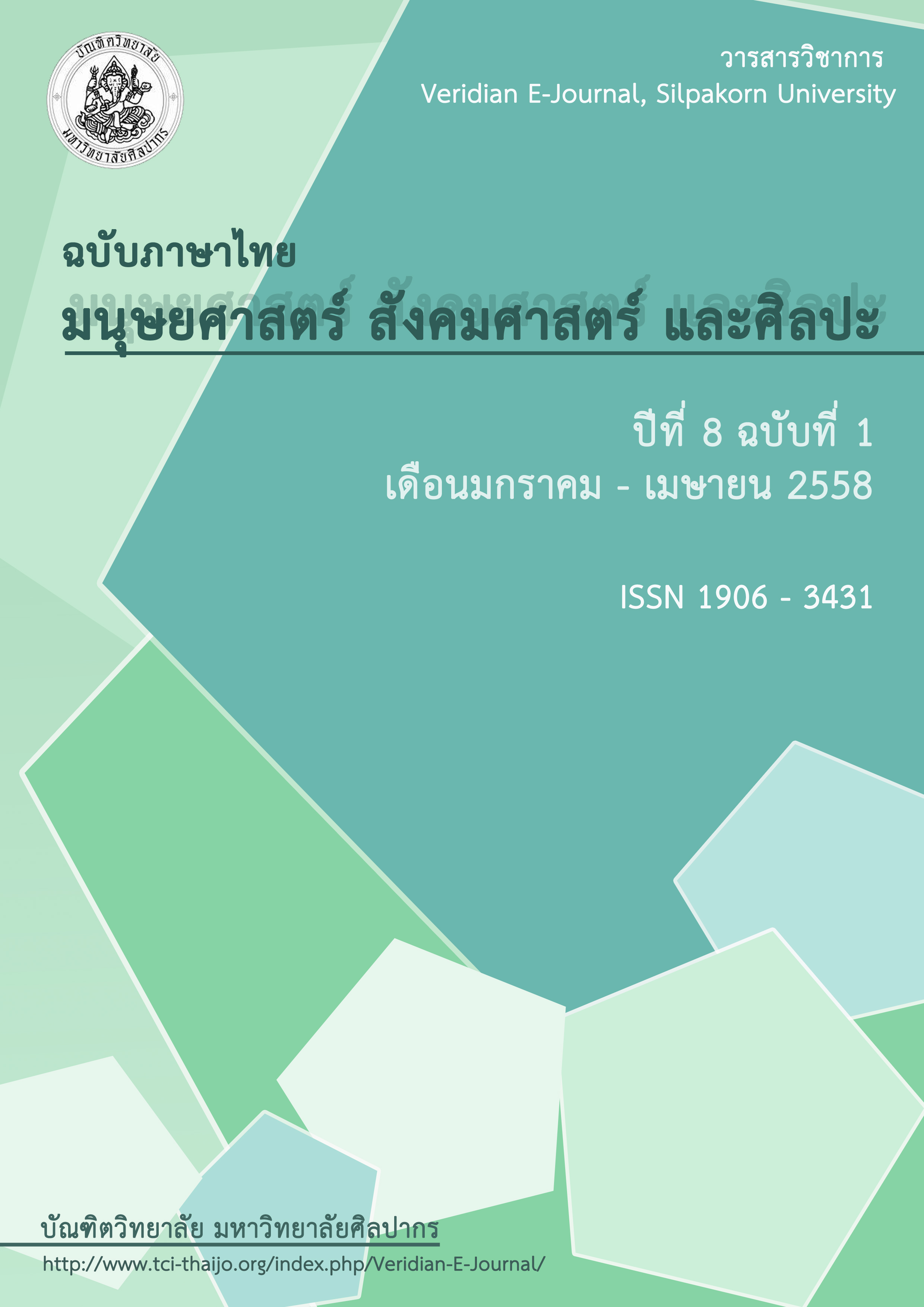ปัจจัยและแนวโน้มการใช้กล้องดิจิทัลสะท้อนภาพเลนส์เดี่ยวแบบบันทึกวีดิทัศน์ (Video-DSLR) ในการถ่ายทำภาพยนตร์
Main Article Content
Abstract
บทคัดย่อ
การวิจัยครั้งนี้มีวัตถุประสงค์เพื่อการศึกษาปัจจัย ปัญหา/อุปสรรค การยอมรับและแนวโน้มการใช้กล้องดิจิทัลสะท้อนภาพเลนส์เดี่ยวแบบบันทึกวีดิทัศน์ในการถ่ายทำภาพยนตร์ รวมถึงศึกษาเปรียบเทียบกับสื่อเก่าอย่างกล้องภาพยนตร์และกล้องวิดีโอ เพื่อเผยแพร่ผลการศึกษาสู่ผู้ประกอบการ ผู้ผลิตสื่อ นักเรียน/นักศึกษาและผู้สนใจใช้กล้องดิจิทัลสะท้อนภาพเลนส์เดี่ยวแบบบันทึกวีดิทัศน์ในการถ่ายทำภาพยนตร์ และใช้เป็นแนวทางพัฒนาความรู้และทักษะให้กับนักศึกษา ในรายวิชาที่เกี่ยวข้องกับการผลิตภาพยนตร์ โดยการวิจัยครั้งนี้เป็นการวิจัยเชิงคุณภาพ (Qualitative Research) มีการศึกษาและเก็บรวบรวมข้อมูลจากเอกสารและการสัมภาษณ์ผู้เชี่ยวชาญแบบเจาะลึก (In-depth Interview) จำนวน 27 ท่าน จากนั้นนำข้อมูลที่ได้มาประมวลผลและนำเสนอผลการวิจัยด้วยวิธีการวิเคราะห์พรรณนา (Descriptive Analysis)
ผลการวิจัยพบว่า 1) ปัจจัยที่ผู้ใช้งานคำนึงถึงและส่งผลต่อการเลือกใช้กล้องดิจิทัลสะท้อนภาพเลนส์เดี่ยวแบบบันทึกวีดิทัศน์ในการถ่ายทำภาพยนตร์ ได้แก่ ปัจจัยด้านราคาของกล้อง DSLR ปัจจัยด้านงบประมาณในการผลิต ปัจจัยด้านคุณภาพของภาพ และปัจจัยด้านลักษณะการใช้งาน โดยปัจจัยด้านราคาของกล้อง DSLR เป็นปัจจัยหลักที่ผู้ใช้ทุกระดับให้ความสำคัญ 2) ปัญหาและอุปสรรคเป็นปัญหาที่เกิดขึ้นเกิดจากตัวนวัตกรรมหรือตัวกล้อง DSLR เอง คือ ปัญหาจากความร้อนภายในตัวกล้อง DSLR ปัญหาจากความยาวของการบันทึกไฟล์ต่อเนื่อง ปัญหาจากระบบบันทึกเสียงของกล้อง DSLR และปัญหาจากการจับถือกล้อง DSLR โดยปัญหาจากความร้อนภายในตัวกล้อง DSLR เป็นปัญหาหลักที่ผู้ใช้ทุกกลุ่มเห็นตรงกัน 3) การยอมรับและแนวโน้มการใช้กล้อง DSLR ผู้ใช้ส่วนใหญ่ทุกระดับให้การยอมรับนวัตกรรมของกล้อง DSLR จนถึงขั้นการนำไปใช้ปฏิบัติงานจริง โดยการยอมรับการใช้งานเป็นผลมาจากปัจจัยด้านราคาของกล้อง ปัจจัยด้านงบประมาณในการผลิต ปัจจัยด้านคุณภาพของภาพ ปัจจัยด้านลักษณะการใช้งาน และผู้ใช้ยอมรับปัญหาของกล้องที่เกิดขึ้นระหว่างการใช้งานได้ด้วย แต่จะมีผู้ผลิตภาพยนตร์บางส่วนเท่านั้นที่ยังไม่ยอมรับการใช้กล้อง DSLR ในการถ่ายทำภาพยนตร์ แต่ก็ไม่ได้ปฏิเสธการใช้กล้อง DSLR ไปเลย เนื่องจากผู้ผลิตภาพยนตร์บางส่วนนี้ยังมีความรู้สึกดีกับการถ่ายภาพยนตร์ด้วยฟิล์มภาพยนตร์หรือด้วยกล้องภาพยนตร์ ส่วนแนวโน้มการใช้กล้อง DSLR ในการถ่ายทำภาพยนตร์มีแนวโน้มการใช้งานเพิ่มมากขึ้น เป็นเพราะการยอมรับการใช้กล้อง DSLR ในการถ่ายทำภาพยนตร์ของผู้ผลิตสื่อทั้งในประเทศและต่างประเทศ นักวิชาการด้านภาพยนตร์/ผลิตรายการโทรทัศน์ และดูแบบอย่างจากผู้อื่นที่ประสบผลสำเร็จก่อนหน้านี้ จึงทำให้แนวโน้มการใช้กล้อง DSLR เพิ่มมากขึ้น 4) การเปรียบเทียบการใช้งานของกล้อง DSLR กับสื่อเก่าอย่างกล้องภาพยนตร์หรือกล้องวิดีโอคุณภาพสูงนั้น ผู้ใช้งานทุกกลุ่มมีความเห็นตรงกันว่าไม่สามารถนำมาเปรียบเทียบกันได้ เพราะว่ากล้องแต่ละชนิดถูกออกแบบและพัฒนามาคนละหลักการกัน จึงทำให้กล้อง DSLR สามารถถ่ายได้ทั้งภาพนิ่งและวิดีโอ ส่วนกล้องภาพยนตร์หรือกล้องวิดีโอคุณภาพสูงได้รับการออกแบบและพัฒนา เพื่อการถ่ายวิดีโอหรือภาพเคลื่อนไหวเท่านั้น
Abstract
The objectives of this research are (1) to study the factors, the problems/obstacles, the acceptance, and the trends in the usage of Video Digital Single Lens Reflex camera in cinematography (2) to compare the DSLR camera with the cinematography and video camera (3) to improve the knowledge and the skills for students who enrolled in cinematography courses. The findings will be disseminated to entrepreneurs, media producers, students, and for those who are interested. The present study employed qualitative method. The data was collected from the documents and the interviews which was conducted with 27 experts. The data was analyzed and presented by means of descriptive analysis.
The findings indicated that (1) the factors that affect the choice of users in using DSLR camera in cinematography are the price, production budget, the quality of the image and the functions. The main factor which all levels of users focus on is the price of DSLR camera (2) The problems/obstacles caused by the innovation of DSLR are the overheating of the body of the camera, the length of the continuous recording file, the sound recording system and the grip of the camera. The overheating is main problem identified by all groups of users (3) as for the approval in the use of DSLR camera, it is found that most users approve the innovation of the camera that can be applied in the real practice. Such approval is the result from the price of the camera, production budget, the quality of the image and the functions. Moreover, the users accept the problems that may have occurred during the process of using. However, some producers are still reluctant in using DSLR camera in cinematography due to the good attitude toward cinematography camera or video camera for recording even they are not totally against DSLR camera. Furthermore, the trends in using DSLR camera in cinematography are also increasing as the result of the increasing numbers of domestic and international producers, film scholars, and television producers in using DSLR camera as seen from the previous successes (4) regarding the differences between the DSLR and the video camera, it is found that all users have the same opinion that both types of cameras cannot be compared as each type of camera has been designed and developed based on different set of principles. Hence, it is concluded that DSLR camera can be used to record still and motion pictures whereas VDO camera is only for recording video clips and motion pictures.
